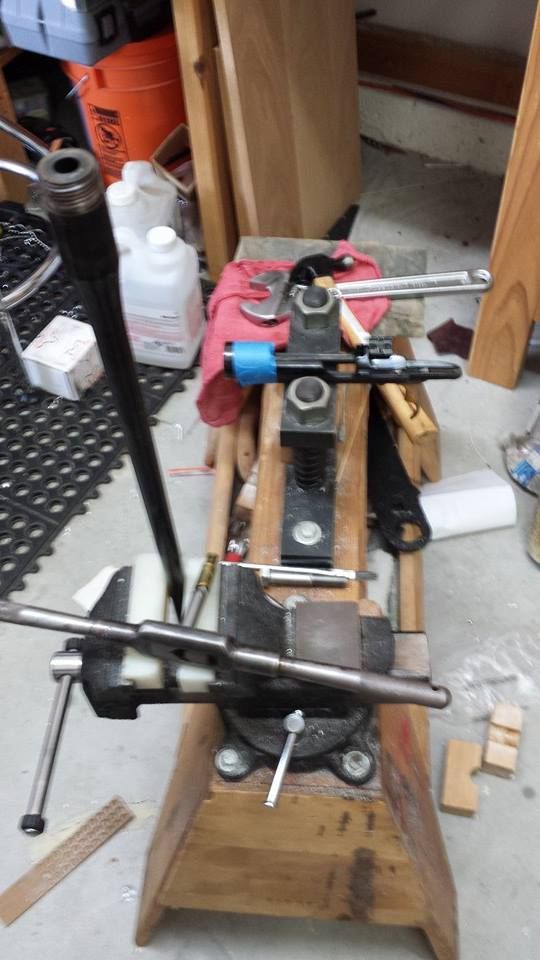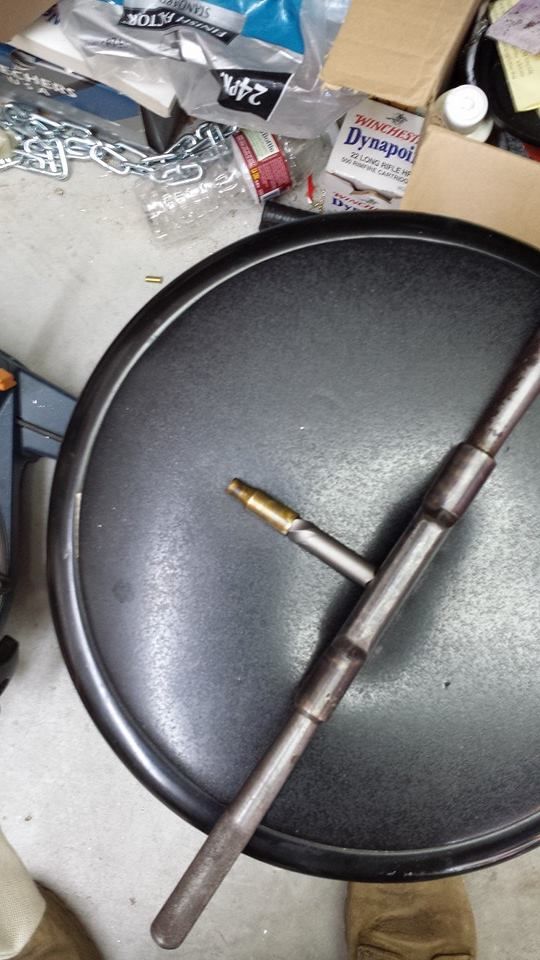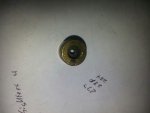Gunsmithing Case head separation
- Thread starter greggrissom
- Start date
You are using an out of date browser. It may not display this or other websites correctly.
You should upgrade or use an alternative browser.
You should upgrade or use an alternative browser.
It's not a 'gun' issue. Brass will wear out, especially when ran hot enough to stamp the ejector void as well as it has done. If that was done on a 'normal' load, then you will soon have a gun issue.
Regards
Pete
Regards
Pete
That wasn't even max load.That was 46.5 H4350 under a 168gr SMK. I'm more worried about getting the rest of the piece of brass out. That was the 4th firing on 260 lapua brass necked up to 7mm. How can I get the brass out?
Case head separation is a classic sign of too much headspace, and not in the weapon but in the brass, how did you setup your FL die, did you use a Headspace Gauge or did you adjust the die per the instructions that come with most FL dies. As for what's left inside the chamber get a broken shell extractor.
Depending on how tight it is, you may be able to push an oversized brass cleaning brush into the neck area, and then pull it back out. Don't go too big, you don't want it jammed in there. The bristles will catch the case mouth and try to pull it out. The next option is to cut the neck off another piece of brass, put a little JB Weld on it, and push it into the back of the broken case. After the epoxy sets, extract them as normal. Dont get epoxy everywhere.
Be advised that necking Lapua brass up pretty much always results in a donut.
I'm assuming you're rocking a 7mm08, in which case, if you're loading to a COAL of less than ~2.850, you're seating the bullet into the donut.
Might could be why you're seeing huge pressure when the charge weight doesn't seem extraordinary.
I'm assuming you're rocking a 7mm08, in which case, if you're loading to a COAL of less than ~2.850, you're seating the bullet into the donut.
Might could be why you're seeing huge pressure when the charge weight doesn't seem extraordinary.
That wasn't even max load.That was 46.5 H4350 under a 168gr SMK. I'm more worried about getting the rest of the piece of brass out. That was the 4th firing on 260 lapua brass necked up to 7mm. How can I get the brass out?
This works great. Never needed one for my own guns.... but I've helped out quite a few over zealous full length resize reloaders
www.brownells.com/gunsmith-tools-su...emovers/broken-shell-extractor-prod23311.aspx
See that circle at the 6 o'clock position on the case head? That is the impression of your ejector pin hole in your bolt face. You can see the circle because you had enough pressure to extrude some brass into the hole. It is shiny because the extruded brass got shaved off when you opened the bolt. Since the case head separated, you probably didn't have to hammer the bolt open. (You may ask me how I know this) It is not normal to have that much pressure. There is no primer in that case head. Did the primer just fall out when you ejected the case head? If your primer pockets don't hold the primer that is another sign of excessive pressure.
You should be able to push the rest of the case body out of the chamber with a tight fitting brush pushed from the muzzle end.
Reloading books are guidelines, not the law. This gun is telling you that charge is too hot. The gun is ALWAYS right. Listen to what the gun is telling you.
You may be a fine looking fellow but I guarantee that you won't look as good when the locking lugs sheer off and what is left of the bolt flies through the back of your head. The diameter of your case head is .479. The area of the case head is about .180 square inches. Assuming that the chamber pressure is 60,000 PSI, the case head thrust is a little over 10,000 pounds. Given that mark on the case head, I suspect that the chamber pressure is upwards of 70,000 PSI.
I have been present when two guys blew up bolt action guns. One guy left the range horizontal in an ambulance, I think he lived but for sure they had to sew his scalp back on. The second guy was so high on adrenalin that he was literally bouncing around the range shouting with blood running down his face and chest from the holes made by the brass and shrapnel when the action blew. His eyes were okay. The last I saw he was sitting up in the ambulance still jabbering, his wife came and picked up his guns and other stuff. Don't be like those guys.
Most likely, the head separation was produced by reloading technique (you probably set the shoulder back too far) but high pressure can aggravate the situation.
You should be able to push the rest of the case body out of the chamber with a tight fitting brush pushed from the muzzle end.
Reloading books are guidelines, not the law. This gun is telling you that charge is too hot. The gun is ALWAYS right. Listen to what the gun is telling you.
You may be a fine looking fellow but I guarantee that you won't look as good when the locking lugs sheer off and what is left of the bolt flies through the back of your head. The diameter of your case head is .479. The area of the case head is about .180 square inches. Assuming that the chamber pressure is 60,000 PSI, the case head thrust is a little over 10,000 pounds. Given that mark on the case head, I suspect that the chamber pressure is upwards of 70,000 PSI.
I have been present when two guys blew up bolt action guns. One guy left the range horizontal in an ambulance, I think he lived but for sure they had to sew his scalp back on. The second guy was so high on adrenalin that he was literally bouncing around the range shouting with blood running down his face and chest from the holes made by the brass and shrapnel when the action blew. His eyes were okay. The last I saw he was sitting up in the ambulance still jabbering, his wife came and picked up his guns and other stuff. Don't be like those guys.
Most likely, the head separation was produced by reloading technique (you probably set the shoulder back too far) but high pressure can aggravate the situation.
Thanks for everyone's help. I use a Redding Body die to resize the body and bump the shoulder back. I use a Hornady case guage to check headspace and I measure COAL off the ogive. I use a Lee Collet die to size the neck back down. I try to keep the headspace length around 1.621 - .622. Everyone so often one sizes down to 1.617 or lower and I guess this was one of those. I try to check every piece of brass I resize and load. I guess this one got away from me. Oh, and yes I am shooting 7-08. If the headspace length is too short, should it be pulled? Is it recommended to fireform it again? Hoping for more help.
Post #7 gives a good clue.
Check for donuts, you may have to ream your brass after necking it up. Then keep an eye on it re-appearing.
Personally, I'd just neck size (once reamed) until it gets a bit tight closing the bolt on an unfired round, then just bump the shoulders back enough to close with little effort, rather than each firing. Your brass will last lots longer too.
The only people I know with a 7/08 size .308 down rather than 243/260 up. Then neck turn if needed for chamber clearance.
Regards
Pete
Check for donuts, you may have to ream your brass after necking it up. Then keep an eye on it re-appearing.
Personally, I'd just neck size (once reamed) until it gets a bit tight closing the bolt on an unfired round, then just bump the shoulders back enough to close with little effort, rather than each firing. Your brass will last lots longer too.
The only people I know with a 7/08 size .308 down rather than 243/260 up. Then neck turn if needed for chamber clearance.
Regards
Pete
Any chance your scale wasn't leveled first or you used the wrong powder by accident. Did you try to substitute aa4350 or imr 4350 thinking the burn rate is similar because they aren't.Your load sounds extremely hot! Try to go back to the basics and start over with a work up looking and measuring for head expansion. The primer doesn't always tell the whole story with pressure problems. Measure everything including the bullets,and take a paper clip and bend the end over at 90 degrees and feel for signs of insipient head separation on the emptys that didn't separate.Please for safetys sake do this and get it borescoped as a heavy carbon ring in the chamber can and will build up and cause an unexpected pressure spike.
Broken shells/case head separations happen, and for a variety of reasons. The broken shell extractors linked in this thread are for .308 and .223, and work with varying degrees of effectiveness. A broken screw extractor will work as well. While the barrel can be left on the action, the attached photos show a Mauser (in .308) I had to remove a broken shell from, that I went ahead and pulled the barrel on for ease of removing the shell. The Brownell's tool would not work, as the person who owned the rifle didn't realize he had a case head separation, and tried to ram another round in after this one broke off. I want to say this was a metric broken screw remover...
Just follow the instructions of the broken screw extractor and it will work fine (with the appropriate sized one).


Checked my bench, and it was an Irwin EX-5 broken screw remover.
Just follow the instructions of the broken screw extractor and it will work fine (with the appropriate sized one).


Checked my bench, and it was an Irwin EX-5 broken screw remover.
Last edited:
Yikes!!!
Case/ head separation is caused by a few problems, pressure, headspace, worn out brass. But I'm sure you already know that. As for removing the case from the chamber, I take a case of the same caliber, degrease it and the inside of the stuck case, and mix up a bit of jb weld and then tap the good case into the stuck case and let dry overnight. Then with apply a small (small!!!) amount of heat around the chamber, do not melt the jb weld, and with a stiff rod tap the cases out from the muzzle. Works every time! Then check pressure and headspace.
Just curious, what does new unfired brass measure to the shoulder compared to fired brass? Have you actually checked the headspace with gauges yet? I've had a custom rifle come back to me before that was .020" too long on headspace. Don't take it for granted that everything is right. Fwiw, starting loads from the books in that rifle with excessive headspace had flattened primers, shiny ejector marks, heavy bolt lift.
More re than likely you are over sizing your brass but just be sure...
More re than likely you are over sizing your brass but just be sure...
Thanks for everyone's help. I use a Redding Body die to resize the body and bump the shoulder back. I use a Hornady case guage to check headspace and I measure COAL off the ogive. I use a Lee Collet die to size the neck back down. I try to keep the headspace length around 1.621 - .622. Everyone so often one sizes down to 1.617 or lower and I guess this was one of those. I try to check every piece of brass I resize and load. I guess this one got away from me. Oh, and yes I am shooting 7-08. If the headspace length is too short, should it be pulled? Is it recommended to fireform it again? Hoping for more help.
Something goofy is going on, serious stretching if Lapua cases are letting go in 4 firings.
http://www.snipershide.com/shooting...9147-how-many-loads-out-260-rem-r-p-case.html
The link above is a test I did with Remington .260 brass reloading the same case until it failed. I only got a partial seperation (thank you baby Jesus) with no damage done to anything but the case. I get more than 6 loads usually out of 1940's military 30-06 brass in my M1 Garand (horrible about stretching cases).
Anyway, it is interesting to note that the last firing of my case where it let go, was the one and only time I got excessive pressure signs (ejector print/swipe). The load I was shooting was pretty mild, but the last firing where the case let go, the brass did flow into the ejector pocket a bit.
You hemorage cases two ways.
bangin the press too much with a sizer and...
...bangin the press too much with the sizer.
if your chamber is deep the case will fire form. If you KNOW the chamber is too deep just seat the pill long with lots of neck tension. Back off the load. Single load the first time around. Then bump the shoulder kust enough to get reliable feeding.
With a properly cut chamber you can get well over 20 reloads with Lapua brass. I have a gent in Phoenix that went 31 reloads on a 6.5x47 case before it finally gave out.
C.
bangin the press too much with a sizer and...
...bangin the press too much with the sizer.
if your chamber is deep the case will fire form. If you KNOW the chamber is too deep just seat the pill long with lots of neck tension. Back off the load. Single load the first time around. Then bump the shoulder kust enough to get reliable feeding.
With a properly cut chamber you can get well over 20 reloads with Lapua brass. I have a gent in Phoenix that went 31 reloads on a 6.5x47 case before it finally gave out.
C.
Last edited:
Broken shells/case head separations happen, and for a variety of reasons. The broken shell extractors linked in this thread are for .308 and .223, and work with varying degrees of effectiveness. A broken screw extractor will work as well. While the barrel can be left on the action, the attached photos show a Mauser (in .308) I had to remove a broken shell from, that I went ahead and pulled the barrel on for ease of removing the shell. The Brownell's tool would not work, as the person who owned the rifle didn't realize he had a case head separation, and tried to ram another round in after this one broke off. I want to say this was a metric broken screw remover...
Just follow the instructions of the broken screw extractor and it will work fine (with the appropriate sized one).


Checked my bench, and it was an Irwin EX-5 broken screw remover.
That brick of .22 in the background for sale?
OP you are giving the size of the case after resizing, how much are you bumping back the case, what is the measurement of a fired case? Have you shecked you seating depth vs your lands, if too far in this could cause a spike also.
That brick of .22 in the background for sale?
LOL! Good eye; nope, it's almost empty anyways...
Wow. That's some serious stretching. Good brass like that and only so few firings...somethings not jiving. Have you tried neck sizing?
Similar threads
- Replies
- 27
- Views
- 652
- Replies
- 2
- Views
- 328

